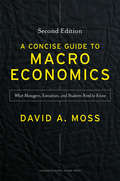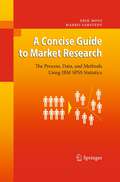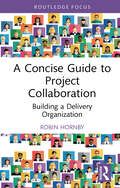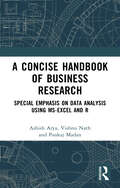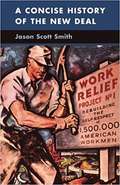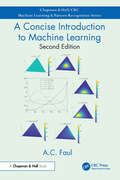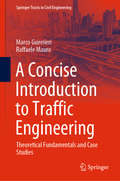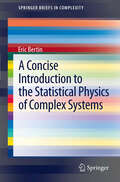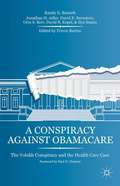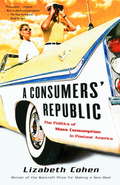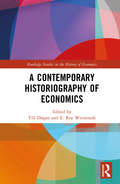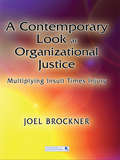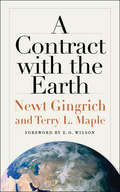- Table View
- List View
A Concise Guide to Macroeconomics, Second Edition
by David A. MossWhat managers need to know about macroeconomics-but are afraid to askNow more than ever before, executives and managers need to understand their larger economic context. In A Concise Guide to Macroeconomics, David Moss leverages his many years of teaching experience at Harvard Business School to lay out important macroeconomic concepts in engaging, clear, and concise terms. Now fully updated, this classic resource also includes a new chapter on the global financial crisis.In a simple and intuitive way, Moss breaks down the ideas into output, money, and expectations. He also introduces powerful tools for interpreting the big-picture economic developments that shape events in the contemporary business arena. The book includes detailed examples drawn from history to illuminate important concepts and leaves the reader with a clearer picture of how our economy actually works-and what impact in has on business.A classic resource by a leading thinker in the field, A Concise Guide to Macroeconomics is the primer on macroeconomics every manager needs.
A Concise Guide to Macroeconomics, Second Edition
by David A. MossUnderstanding the Ground Rules for the Global EconomyIn this revised and updated edition of A Concise Guide to Macroeconomics, David A. Moss draws on his years of teaching at Harvard Business School to explain important macro concepts using clear and engaging language.This guidebook covers the essentials of macroeconomics and examines, in a simple and intuitive way, the core ideas of output, money, and expectations. Early chapters leave you with an understanding of everything from fiscal policy and central banking to business cycles and international trade. Later chapters provide a brief monetary history of the United States as well as the basics of macroeconomic accounting. You'll learn why countries trade, why exchange rates move, and what makes an economy grow.Moss's detailed examples will arm you with a clear picture of how the economy works and how key variables impact business and will equip you to anticipate and respond to major macroeconomic events, such as a sudden depreciation of the real exchange rate or a steep hike in the federal funds rate.Read this book from start to finish for a complete overview of macroeconomics, or use it as a reference when you're confronted with specific challenges, like the need to make sense of monetary policy or to read a balance of payments statement. Either way, you'll come away with a broad understanding of the subject and its key pieces, and you'll be empowered to make smarter business decisions.
A Concise Guide to Market Research: The Process, Data, and Methods Using IBM SPSS Statistics (Springer Texts in Business and Economics)
by Erik Mooi Marko SarstedtThis accessible, practice-oriented and compact text provides a hands-on introduction to the principles of market research. Using the market research process as a framework, the authors explain how to collect and describe the necessary data and present the most important and frequently used quantitative analysis techniques, such as ANOVA, regression analysis, factor analysis, and cluster analysis. An explanation is provided of the theoretical choices a market researcher has to make with regard to each technique, as well as how these are translated into actions in IBM SPSS Statistics. This includes a discussion of what the outputs mean and how they should be interpreted from a market research perspective. Each chapter concludes with a case study that illustrates the process based on real-world data. A comprehensive web appendix includes additional analysis techniques, datasets, video files and case studies. Several mobile tags in the text allow readers to quickly browse related web content using a mobile device.
A Concise Guide to Market Research: The Process, Data, and Methods Using IBM SPSS Statistics (Springer Texts in Business and Economics)
by Erik Mooi Marko SarstedtThis accessible, practice-oriented and compact text provides a hands-on introduction to market research. Using the market research process as a framework, it explains how to collect and describe data and presents the most important and frequently used quantitative analysis techniques, such as ANOVA, regression analysis, factor analysis and cluster analysis. The book describes the theoretical choices a market researcher has to make with regard to each technique, discusses how these are converted into actions in IBM SPSS version 22 and how to interpret the output. Each chapter concludes with a case study that illustrates the process using real-world data. A comprehensive Web appendix includes additional analysis techniques, datasets, video files and case studies. Tags in the text allow readers to quickly access Web content with their mobile device. The new edition features: Stronger emphasis on the gathering and analysis of secondary data (e. g. , internet and social networking data) New material on data description (e. g. , outlier detection and missing value analysis) Improved use of educational elements such as learning objectives, keywords, self-assessment tests, case studies, and much more Streamlined and simplified coverage of the data analysis techniques with more rules-of-thumb Uses IBM SPSS version 22
A Concise Guide to Market Research: The Process, Data, and Methods Using IBM SPSS Statistics (Springer Texts in Business and Economics)
by Erik Mooi Marko SarstedtThis book offers an easily accessible and comprehensive guide to the entire market research process, from asking market research questions to collecting and analyzing data by means of quantitative methods. It is intended for all readers who wish to know more about the market research process, data management, and the most commonly used methods in market research. The book helps readers perform analyses, interpret the results, and make sound statistical decisions using IBM SPSS Statistics. Hypothesis tests, ANOVA, regression analysis, principal component analysis, factor analysis, and cluster analysis, as well as essential descriptive statistics, are covered in detail. Highly engaging and hands-on, the book includes many practical examples, tips, and suggestions that help readers apply and interpret the data analysis methods discussed. The new edition uses IBM SPSS version 25 and offers the following new features:A single case and dataset used throughout the book to facilitate learningNew material on survey design and all data analysis methods to reflect the latest advances concerning each topicImproved use of educational elements, such as learning objectives, keywords, self-assessment tests, case studies, and much moreA glossary that includes definitions of all the keywords and other descriptions of selected topics Links to additional material and videos via the Springer Multimedia App
A Concise Guide to Project Collaboration: Building a Delivery Organization
by Robin HornbyEasy to read and act on immediately, this concise guide shows how organizations can work more effectively with in-house or contracted project managers and their teams, using specific collaborative techniques to improve success rates, reduce project costs, and enable organizations to benefit from common-sense, cost-effective project management approaches that work. Using a clear structure and accessible style, the book demonstrates how: Managers can create an organizational environment more naturally adapted for project work and recognition of business priorities; Barriers to project work can be removed so project managers can focus on resolving real project problems; Specific collaborative project management methods engaging business owners, users, and technical teams can be illuminated and implemented; Projects can fit within an architecture that aligns with business needs using models and workflow designs; and Standardized delivery management can unify in-house and vendor teams to create a uniform and predictable owner experience. The book is aimed at managers and executives (both IT and users) in corporations and vendor firms who are engaged in delivering projects. The book will also be invaluable to any project manager or senior practitioner who is interested in a business-oriented, unified, and collaborative approach to project management.
A Concise Handbook of Business Research: Special Emphasis on Data Analysis Using MS-Excel and R
by Vishnu Nath Ashish Arya Pankaj MadanThis book deals with the basics of Research Methodology (RM) for Business Research and statistical analysis for dealing with data using two software: R (a free statistical analysis environment) and MS-Excel. Apart from the basic concepts of Research Methodology, the book contains an additional chapter on improving academic writing. It contains important details on plagiarism, citation and referencing in MS-Word, and improving project/dissertation writing using free online software. Print edition not for sale in South Asia (India, Sri Lanka, Nepal, Bangladesh, Pakistan or Bhutan)
A Concise History of the New Deal
by Jason Scott SmithDuring the 1930s, Franklin D. Roosevelt's New Deal carried out a program of dramatic reform to counter the unprecedented failures of the market economy exposed by the Great Depression. Contrary to the views of today's conservative critics, this book argues that New Dealers were not "anticapitalist" in the ways in which they approached the problems confronting society. Rather, they were reformers who were deeply interested in fixing the problems of capitalism, if at times unsure of the best tools to use for the job. In undertaking their reforms, the New Dealers profoundly changed the United States in ways that still resonate today. Lively and engaging, this narrative history focuses on the impact of political and economic change on social and cultural relations.
A Concise Introduction to Financial Derivatives
by Eben MaréA Concise Introduction to Financial Derivatives seeks to present financial derivatives in a manner that requires minimal mathematical background. Readers will obtain, in a quick and engaging way, a working knowledge of the field and a collection of practical working insights. The book is ideal for aspiring young practitioners, advanced undergraduates, and masters-level students who require a concise and practice-led introduction to financial derivatives.Features:• Practical insights and modelling skills• Accessible to practitioners and students without a significant mathematical backgroundEben Maré holds responsibility for absolute return portfolio management and has been working in the financial markets for the last 33 years. He has also held senior roles in risk management, treasury, derivatives trading, and asset management. He has a PhD in Applied Mathematics and is an associate professor in Mathematics and Applied Mathematics at the University of Pretoria in South Africa. He has wide research interests in financial derivatives, asset management, and financial markets.
A Concise Introduction to Machine Learning
by A.C. FaulThe emphasis of the book is on the question of Why – only if why an algorithm is successful is understood, can it be properly applied, and the results trusted. Algorithms are often taught side by side without showing the similarities and differences between them. This book addresses the commonalities, and aims to give a thorough and in-depth treatment and develop intuition, while remaining concise. This useful reference should be an essential on the bookshelves of anyone employing machine learning techniques. The author's webpage for the book can be accessed here.
A Concise Introduction to Machine Learning (Chapman & Hall/CRC Machine Learning & Pattern Recognition)
by A.C. FaulA Concise Introduction to Machine Learning uses mathematics as the common language to explain a variety of machine learning concepts from basic principles and illustrates every concept using examples in both Python and MATLAB®, which are available on GitHub and can be run from there in Binder in a web browser. Each chapter concludes with exercises to explore the content.The emphasis of the book is on the question of Why—only if “why” an algorithm is successful is understood, can it be properly applied and the results trusted. Standard techniques are treated rigorously, including an introduction to the necessary probability theory. This book addresses the commonalities of methods, aims to give a thorough and in-depth treatment and develop intuition for the inner workings of algorithms, while remaining concise.This useful reference should be essential on the bookshelf of anyone employing machine learning techniques, since it is born out of strong experience in university teaching and research on algorithms, while remaining approachable and readable.
A Concise Introduction to Traffic Engineering: Theoretical Fundamentals and Case Studies (Springer Tracts in Civil Engineering)
by Raffaele Mauro Marco GuerrieriThis book covers a selection of fundamental topics of traffic engineering useful for highways facilities design and control. The treatment is concise but it does not neglect to examine the most recent and crucial theoretical aspects which are at the root of numerous highway engineering applications, like, for instance, the essential aspects of highways traffic stream reliability calculation and automated highway systems control. In order to make these topics easy to follow, several illustrative worked examples of applications are provided in great detail. An intuitive and discursive, rather than formal, style has been adopted throughout the contents. As such, the book offers up-to-date and practical knowledge on several aspects of traffic engineering, which is of interest to a wide audience including students, researchers as well as transportation planners, public transport specialists, city planners and decision-makers.
A Concise Introduction to the Statistical Physics of Complex Systems (SpringerBriefs in Complexity)
by Eric BertinThis concise primer (based on lectures given at summer schools on complex systems and on a masters degree course in complex systems modeling) will provide graduate students and newcomers to the field with the basic knowledge of the concepts and methods of statistical physics and its potential for application to interdisciplinary topics. Indeed, in recent years, statistical physics has begun to attract the interest of a broad community of researchers in the field of complex system sciences, ranging from biology to the social sciences, economics and computer science. More generally, a growing number of graduate students and researchers feel the need to learn some basic concepts and questions originating in other disciplines without necessarily having to master all of the corresponding technicalities and jargon. Generally speaking, the goals of statistical physics may be summarized as follows: on the one hand to study systems composed of a large number of interacting 'entities', and on the other to predict the macroscopic (or collective) behavior of the system considered from the microscopic laws ruling the dynamics of the individual 'entities'. These two goals are, to some extent, also shared by what is nowadays called 'complex systems science' and for these reasons, systems studied in the framework of statistical physics may be considered as among the simplest examples of complex systems--allowing in addition a rather well developed mathematical treatment.
A Connected World: Social Networks and Organizations (Elements in Organization Theory)
by Martin Kilduff Lei Liu Stefano TasselliThis Element synthesizes the current state of research on organizational social networks from its early foundations to contemporary debates. It highlights the characteristics that make the social network perspective distinctive in the organizational research landscape, including its emphasis on structure and outcomes. It covers the main theoretical developments and summarizes the research design questions that organizational researchers face when collecting and analyzing network data. Then, it discusses current debates ranging from agency and structure to network volatility and personality. Finally, the Element envisages future research directions on the role of brokerage for individuals and communities, network cognition, and the importance of past ties. Overall, the Element provides an innovative angle for understanding organizational social networks, engaging in empirical network research, and nurturing further theoretical development on the role of social interactions and connectedness in modern organizations.
A Conspiracy Against Obamacare
by Trevor BurrusThe Affordable Care Act debate was one of the most important and most public examinations of the Constitution in our history. At the forefront of that debate were the bloggers of the Volokh Conspiracy who, from before the law was even passed, engaged in a spirited, erudite, and accessible discussion of the legal issues involved in the case.
A Constructive Meeting: Real World Strategies for Synthesizing Complex Information, Managing Projects under Tight Timelines, and Mitigating Strategic Risks
by Jay Barney Patricia Gorman Clifford"What I Didn't Learn in Business School" is a fictional account that follows new consultant Justin Campbell as he joins an elite team hired by a chemical firm to assess the potential of a newly developed technology. Authors Jay Barney and Trish Gorman Clifford use Justin's story to examine the challenges a recent MBA graduate faces in applying his education on the job-in a way a traditional business book about strategy never could. In this chapter, Justin and his team begin to synthesize all of the information they've gathered on their client organization and its new technology into a set of strategic recommendations. Follow along as the team uncovers holes in their case and divvies up the work that still needs to be done in order to make a defensible initial presentation of their analysis, with a complete assessment of the risk involved, to the client. This chapter was originally published as Chapter 12 of "What I Didn't Learn in Business School: How Strategy Works in the Real World."
A Consumers' Republic: The Politics of Mass Consumption in Postwar America
by Lizabeth CohenIn this signal work of history, Bancroft Prize winner and Pulitzer Prize finalist Lizabeth Cohen shows how the pursuit of prosperity after World War II fueled our pervasive consumer mentality and transformed American life.Trumpeted as a means to promote the general welfare, mass consumption quickly outgrew its economic objectives and became synonymous with patriotism, social equality, and the American Dream. Material goods came to embody the promise of America, and the power of consumers to purchase everything from vacuum cleaners to convertibles gave rise to the power of citizens to purchase political influence and effect social change. Yet despite undeniable successes and unprecedented affluence, mass consumption also fostered economic inequality and the fracturing of society along gender, class, and racial lines. In charting the complex legacy of our "Consumers' Republic" Lizabeth Cohen has written a bold, encompassing, and profoundly influential book.From the Trade Paperback edition.
A Contemporary Historiography of Economics (Routledge Studies in the History of Economics)
by E. Roy Weintraub Till DüppeIn recent years, the focus of historians of economic thought has changed to also include the ideas and practices of contemporary economists. This has opened up new questions regarding the utilization of sources, choice of method, narrative styles, and ethical issues, as well as a new awareness of the historian’s place, role, and task. This book brings together leading contributors to provide, for the first time, a methodological overview of the historiography of economics. Emphasising the quality of the scholarship of recent decades, the book seeks to provide research tools for future historians of economic thought, as well as to any historians of social science with an interest in historiographic issues.
A Contemporary Look at Organizational Justice: Multiplying Insult Times Injury (Organization and Management Series)
by Joel BrocknerThis book is for scholars with an interest in the burgeoning area of theory and research on organizational justice. The ideas it describes forge connections between the justice literature and other prominent bodies of knowledge in organizational and social psychology, including those pertaining to trust, social identity, attribution theory, regulatory focus theory and cross-cultural differences in people's beliefs and behaviors. Though intended primarily for researchers, this book is written in a very accessible way, so that informed practitioners will gain considerable value from it.
A Contest of Ideas: Capital, Politics and Labor
by Nelson LichtensteinFor more than thirty years Nelson Lichtenstein has deployed his scholarship--on labor, politics, and social thought--to chart the history and prospects of a progressive America. A Contest of Ideas collects and updates many of Lichtenstein's most provocative and controversial essays and reviews. These incisive writings link the fate of the labor movement to the transformations in the shape of world capitalism, to the rise of the civil rights movement, and to the activists and intellectuals who have played such important roles. Tracing broad patterns of political thought, Lichtenstein offers important perspectives on the relationship of labor and the state, the tensions that sometimes exist between a culture of rights and the idea of solidarity, and the rise of conservatism in politics, law, and intellectual life. The volume closes with portraits of five activist intellectuals whose work has been vital to the conflicts that engage the labor movement, public policy, and political culture.
A Contingency Theory of Leadership
by Jay W. LorschThe idea of a contingency theory of leadership is not new. In the 1960s several scholars, most notably Frederick Fiedler, argued that effective leadership style depended on situational contingencies, such as the nature of the task-specifically, how certain or uncertain it was. But agreement ended there, as researchers and scholars failed to reach a consensus on what leaders' primary tasks were or on which contingency factors influenced them most. This chapter picks up where those scholars left off, as author and Harvard Business School professor Jay Lorsch places the leader's relationship with followers firmly in the center of his analysis. According to Lorsch, followers' values and expectations must align with the goals set by the leader, communication between the parties must be strong, and the leader must draw effectively on power as a function of position (a directive approach) and on influence through perceived competence and charisma (a participative approach). The appropriate mix will depend on four contingent factors: 1) the leader's power and influence and his or her chosen goals, 2) the followers' expectations, 3) the complexity of the organization, and 4) the certainty or uncertainty of the task. This chapter was originally published as Chapter 15 of "Handbook of Leadership Theory and Practice: A Harvard Business School Centennial Colloquium."
A Continuous Time Econometric Model of the United Kingdom with Stochastic Trends
by Albert Rex Bergstrom Khalid Ben NowmanOver the last thirty years there has been extensive use of continuous time econometric methods in macroeconomic modelling. This 2007 monograph presents a continuous time macroeconometric model of the United Kingdom incorporating stochastic trends. Its development represents a major step forward in continuous time macroeconomic modelling. The book describes the model in detail and, like earlier models, it is designed in such a way as to permit a rigorous mathematical analysis of its steady-state and stability properties, thus providing a valuable check on the capacity of the model to generate plausible long-run behaviour. The model is estimated using newly developed exact Gaussian estimation methods for continuous time econometric models incorporating unobservable stochastic trends. The book also includes discussion of the application of the model to dynamic analysis and forecasting.
A Contract with the Earth
by Newt Gingrich Terry L. MapleFocusing the environmental debate on the principle of common commitment, former Speaker of the House Newt Gingrich and eminent conservationist Terry L. Maple present A Contract with the Earth. They declare a need for bipartisan environmentalism—a new era of environmental stewardship with principles that they believe most Americans will share. While acknowledging that liberals and conservatives do not see eye to eye on many issues, Gingrich and Maple argue successfully that environmental stewardship is a mainstream value that transcends partisan politics. Their thoughtful approaches to our environmental challenges are based on three main premises: environmental leadership is integral to America's role in the world, technologically savvy environmental entrepreneurs can and should be the cornerstone of environmental solutions, and cooperation and incentives must be dramatically increased to achieve workable and broadly supported environmental solutions.Gingrich and Maple believe that most people—regardless of how they categorize themselves politically—are weary of the legal and political conflicts that prevent individuals and communities from realizing the benefits of environmental conservation. The foundation of the book—a ten-point Contract with the Earth—promotes ingenuity over rhetoric as the way forward.
A Contractarian Approach to Law and Justice: Live and Let Live
by William E. O’Brian Jr.This book presents a distinctive version of a contractarian approach to law and justice. The work argues that law and justice are social norms that arise from a process of social evolution, and are binding only if and to the extent that they are mutually beneficial. It explicitly rejects accounts of law and justice that are based on morality, on the basis that morality itself is only legitimately founded on mutual advantage. But it also rejects most existing versions of contractarianism, which are based on ideas of hypothetical agreements by rational contractors, in favour of an approach that is based on actually existing social norms, but advocates critically examining these norms and discarding those that are not truly mutually beneficial. The first half of the book develops the approach, while the second half explores some of its implications for law. It argues for a left-libertarian approach to property, an approach largely based on the common law of tort, contract and criminal law, and a rejection of most statutory law, which is based not on mutual advantage but rather on benefiting some at the expense of others. However, it ultimately recognises that there are those who want a more extensive state than this approach allows, and advocates a strong form of federalism to allow this, provided robust exit rights are provided. The book combines political philosophy, economics and law into an approach that is broadly libertarian but distinctive in many respects. It will be of interest to scholars in all three of those disciplines.
A Conversation with Ellen J. Kullman, Chairman & CEO of DuPont, 2009-2015
by Lynn S. Paine Will HurwitzEllen J. Kullman, the retired Chairman and CEO of DuPont, describes how she guided the storied science and technology company through a contentious proxy battle with activist investor Trian Partners, which acquired DuPont shares in 2013 and sought to break up the company. Trian's pursuit of board seats led to a 2015 shareholder vote, which DuPont won under Kullman's leadership. In a sweeping interview with Professor Lynn S. Paine, Kullman describes lessons from her experiences navigating the proxy contest that captured national attention as well as about working with your board, setting company strategy, leading a large corporation, evaluating time frames for shareholder returns, measuring stakeholder performance, assessing shareholder engagement, considering joining a new board and boardroom dynamics, and understanding how boards have changed over the years.
